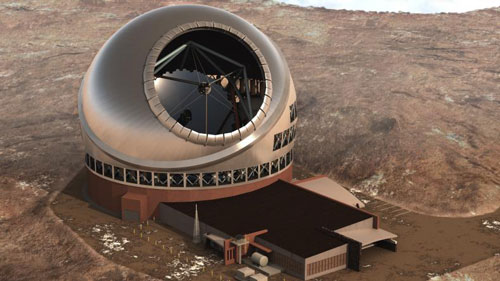| Apr 15, 2013 |
Hawaii approves construction of the most powerful optical telescope on Earth
|
|
(Nanowerk News) Friday marked another important step forward for the future of astronomical discovery and economic opportunity on Hawaii Island. The Hawaiian Board of Land and Natural Resources (BLNR) announced that it has granted a permit to the Thirty Meter Telescope (TMT) project to build and operate the next-generation observatory near the summit of Mauna Kea.
|
|
With this approval, the BLNR has recognized TMT's goal of responsible development and environmental stewardship of Mauna Kea in close partnership with local interests. The carefully considered conditions in the permit help ensure the protection of sensitive environments in Hawaii.
|
 |
| Thirty Meter Telescope
|
|
"Over the last several years, the TMT project has welcomed the support it has received from all sectors of the Hawaiian community, from education to cultural to business to labor," said Sandra Dawson, TMT's Manager of Hawaii Community Affairs. "We look forward to beginning construction and becoming a neighbor of the outstanding observatories on Mauna Kea."
|
|
In February 2011, the BLNR issued a preliminary decision conditioned on the successful conclusion of a contested case. The contested hearings began later that year. The final approval followed a hearing held February 12, 2013 in Hilo, HI. At this time, the BLNR reviewed a report by the hearing officer regarding the contested case.
|
|
"We are delighted that the TMT project has now been granted a Conservation District Use Permit," said Edward Stone, the Morrisroe Professor of Physics at the California Institute of Technology (Caltech) and vice chair of the TMT board. "The BLNR's decision is a vote of confidence for TMT advancing science while benefitting the greater Hawaiian community."
|
|
TMT will now seek final approval of construction plans by Hawaii's Department of Land and Natural Resources (DLNR). The project will also negotiate a sublease with the University of Hawaii. TMT plans to begin preparing the ground for construction on Mauna Kea before the end of the year with a construction start date slated for April 2014.
|
|
TMT Board Chair and University of California Santa Barbara Chancellor Henry Yang expressed his gratitude for the support that TMT has received in Hawaii and elsewhere:
|
|
“I want to thank the Moore Foundation for its visionary support. I also want to thank our scientific colleagues and the coalition of community members, educators, businesses, unions, political leaders, and stakeholders in Hawaii who have brought us to the point of the granting of the CDUP. The TMT Board expresses our strong commitment to respect the long history and cultural significance of Mauna Kea to the Hawaiian people, and has committed annual funding for local community benefits and education in Hawaii.
|
|
We also want to reaffirm that we appreciate what we have learned about the cultural and religious significance of this sacred mountain, as well as the vital ecosystems it supports. It is extremely important to all of us that the Thirty Meter Telescope will be able to make a contribution not only to the exploration of science, but also to the connection of science with humanities, culture, language, religion, environmental sustainability, and education, especially the education of future generations of children in Hawaii," said Yang.
|
|
About TMT
|
|
TMT is the next-generation astronomical observatory that is scheduled to begin scientific operations in 2021 on Mauna Kea, Hawaii. TMT is a collaboration of the California Institute of Technology, University of California, the Association of Canadian Universities for Research in Astronomy, the National Astronomical Observatory of Japan, a consortium of Chinese institutions led by the National Astronomical Observatories of the Chinese Academy of Sciences, and institutions in India supported by the Department of Science and Technology of India. Major funding has been provided by the Gordon & Betty Moore Foundation.
|

